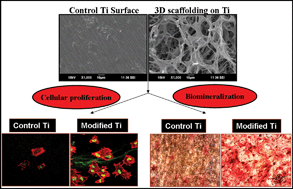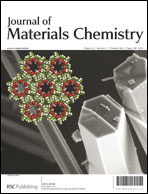One major weakness that all orthopedic implants have in common is the limited osteointegration which results in post-implant loosening. Though biomimetic and biospecific molecules coated on materials were shown to enhance the function of cells, the 3D organization and spatial distribution of these molecules play a critical role in controlling adhesion, growth, viability, differentiation, and function of the cells. Here, we report an approach of surface scaffolding on metallic titanium (Ti) using bioactive natural polymers to enhance osteointegration and bone regeneration as an alternative to surface modification. Instead of just depositing the biomimetic molecules, we constructed a 3D scaffolding of fibrin and alginate on metallic Ti by a method involving chemical crosslinking with dopamine followed by lyophilization. The developed microporous-nanofibrous scaffold showed close resemblance to the native bone matrix in terms of the 3D architecture and was found to be firmly attached to the Ti surfaces. The effectiveness of the obtained scaffold to act as a better matrix for the attachment and proliferation of stem cells and their differentiation into osteogenic lineage was studied using human Mesenchymal Stem Cells (hMSCs). The alkaline phosphatase (ALP) activity and subsequent mineralization of the scaffolds by the differentiated osteoblasts were enhanced greatly by the immobilized scaffold on Ti, eventually leading to bone-like tissue formation over the surface within 2–3 weeks. Thus, the generation of biomimetic 3D scaffolding on Ti surface seems to be a potential approach for improving osteointegration of orthopedic implants in lieu of or in combination with surface modification.

You have access to this article
 Please wait while we load your content...
Something went wrong. Try again?
Please wait while we load your content...
Something went wrong. Try again?


 Please wait while we load your content...
Please wait while we load your content...